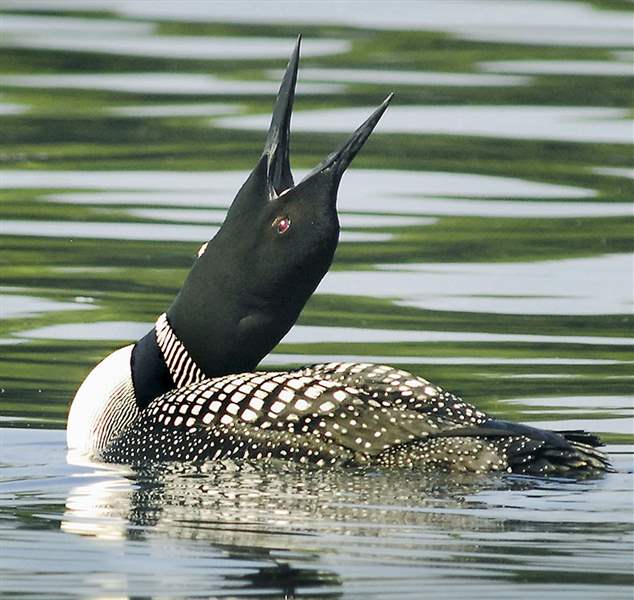
COMMENTARY
Nature always in tune with unique soundtrack
5/20/2014
The loon emits many unique sounds. It squawks when alarmed, yodels to establish a territorial claim, and it wails in an eerie, haunting manner to alert other loons to its location.
BOSTON GLOBE

You want your adult children to remember home as a place that was always warm, comfortable, and welcoming. You hope that in their memories, it was somewhere they felt loved and felt safe.

The loon emits many unique sounds. It squawks when alarmed, yodels to establish a territorial claim, and it wails in an eerie, haunting manner to alert other loons to its location.
I have been assured many times that home was all of those things for my oldest daughter Lauren, who was born in California but spent most of her growing years in rural Wood County. There she raised chickens and pigs, used the pond to become a good swimmer and a great angler, and developed a love of gardening that she has since brought to the big city.
This stridently independent young woman has traveled a lot — Turkey, Greece, France, Spain, Italy, England, Wales, and Scotland — and earned degrees in Spanish and International Business, so her career will not likely bring her back to the setting of her formative years. But home still has a strong place in her life.
During a recent late evening phone conversation with her dear, old dad, while he was standing on the deck soaking in the stars that looked like a tapestry of a million diamonds flung out across a sheet of black velvet, he mentioned the chorus in the background. It was those ever-present “peeper frogs.”
It was then that this beautiful, brilliant, and wise-to-the-world young woman mentioned that one of the things she really missed about home was sleeping with the windows open and listening to those peeper frogs.
We never went to the trouble of capturing these vocalists and determining exactly what species they are, because their music was so soothing, so fit for the night. It is nothing like the deep, low bass guitar thump of the bull frogs in the pond, or the croaks of the leopard frogs along the creek. And there’s a good chance they are actually American toads, but when a 4-year-old called them “peeper frogs” so many years ago, the name stuck.
Lauren’s longing to come home and hear those peeper frogs again got the mind churning about all of the sounds of nature and how they impact us.
Anyone who has spent time in an outpost cabin in the Canadian north country, off on the fringe of civilization, knows the chilling effect of a loon call as it sweeps over the endless wilderness on a still night. It is a wail that is equal parts eerie and delightful. It will haunt you more than a Hitchcock movie and resonate with you for a lifetime.
Birds are the undisputed champions of nature’s sound machine, from the gentle coo of the mourning dove, there to greet you on that early walk, to the deep hoots of the great horned owl late in the night that leave you wondering if he is hunting mice, or you.
Crows torture us with that hoarse-sounding caw that sounds like a couple patrons complaining about the service at the local restaurant, who resent being ignored. Catbirds give us a variety of different meows, without sounding as indignant as the feline in the barn, while the robins in the yard sing like their voices have been professionally tuned.
Some of the most unusual bird sounds are not songs. When a group of Canada geese make a low pass overhead in search of a good feeding spot, their wing motions remind you of the tufts of turbulence that fill the air just after a jet lifts off the runway.
And there is the hummingbird, which did not require a genius to give it a name. We had several nectar feeders in California, with frequent visits from multiple hummingbirds, but the buzz of their flight was always intriguing. Their wings pump at 80 times per second during flight, creating that characteristic “hum,” and when they would hover close to the feeder, the pace and the hum seemed to quicken.
On a recent fishing outing to a remote southern Ohio lake, the only sounds on a still day came from the symphony of birds nesting in the irregular forest surrounding the lake. Without an expert along to sort out the tweets from the chirps, all we could do was enjoy a cascade of song.
On the flip side, a more disconcerting sound of nature emanates from one of the increasingly prevalent residents of our area — the coyote. The homeowners along the Perrysburg side of the Maumee River hear the sinister yips and the alarming howls from the river bottom pack and double-check to make sure the pets are inside.
Another sound only nature can produce is the wind coursing through the leaves of the trees. It whispers and flutters when gentle, snorts and whistles when robust, and howls when angry. The sound stays with us much more powerfully than the visual of moving branches and swaying stems.
The outdoors world is full of natural sounds, and they run the gamut from relaxing to goose bump producing. The next time my daughter comes home, it’s certain she’ll want to enjoy mom’s pasta and a walk through the orchard, but when night falls, she will be expecting a serenade from those peeper frogs. That’s a piece of home the city can’t provide.
Contact Blade outdoors editor Matt Markey at: mmarkey@theblade.com or 419-724-6068.